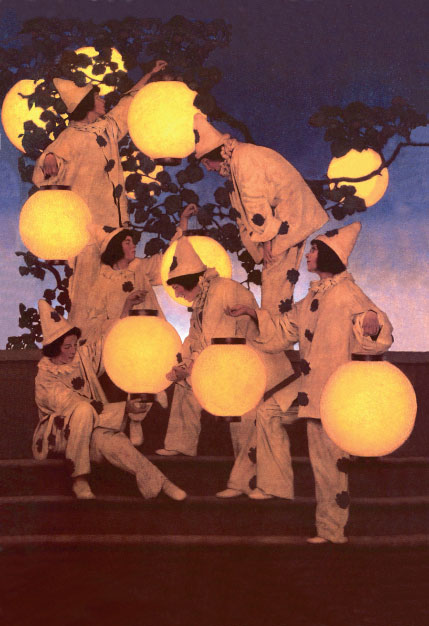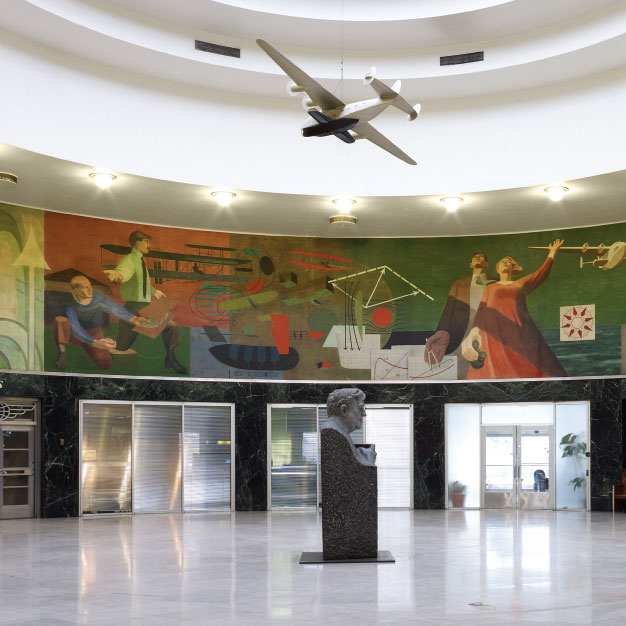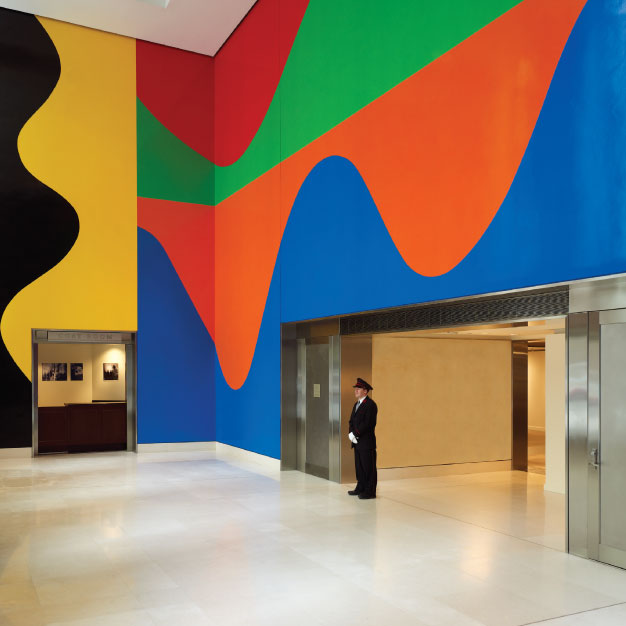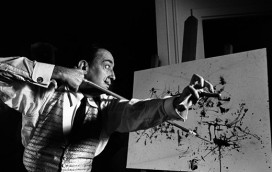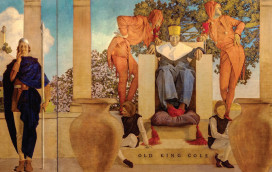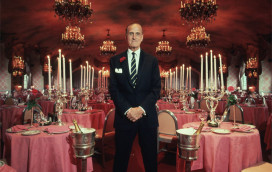On a chilly November night last year, about 120 people squeezed into the King Cole Bar and Salon at The St. Regis New York. The co-host of the evening, fashion designer Jason Wu, wore a dark suit and a slim black tie and stood in the center of the wood-paneled room, welcoming friends and colleagues to a party to celebrate the reopening of the bar after a months-long refurbishment. A DJ played jazz, and models in Wu dresses and celebrities including Emily Mortimer and Uma Thurman dotted the crowd. But the star of the night was a brilliantly-colored painting, just back from a $100,000 restoration and rehung in its place of honor above the bar where it has presided over similarly chic events for almost eight decades.
One hundred and ten years ago, John Jacob Astor IV asked a young artist named Maxfield Parrish if he would like to paint a mural to hang in the bar-room of The Knickerbocker Hotel, Astor’s glamorous new flagship on 42nd Street and Broadway in New York City. The fee was $5,000, extremely generous for the time, but it came with caveats.
First, the subject of the painting had to be Old King Cole, and second, while Parrish would have complete artistic freedom in how he depicted the nursery-rhyme character, he had to use Astor as the model for King Cole’s face.
“At first, Parrish wasn’t sure he wanted the job,” explains Laurence Cutler, chairman of the National Museum of American Illustration and an expert on the artist. “He didn’t like being told he had to do anything.” Parrish had other concerns as well: he came from a conservative Quaker family that frowned on alcohol and wasn’t thrilled that his work would hang in a bar. Plus, he had already painted a version of King Cole for the Mask and Wig Club, a private theater club in Philadelphia.
But Parrish’s father, an established artist with connections in Philadelphia and New York society, encouraged him to reconsider. “Basically, he explained how unadvisable it would be for somebody just starting their career to say no to somebody like Astor.”
Parrish had recently moved from Philadelphia to Plainfield, New Hampshire, where he and his wife, Lydia, were expanding a small estate they had built called The Oaks, which they would live in for the rest of their lives. He realized that the fee, the equivalent of $130,000 today, would set them up well and accepted the commission. He began work on Old King Cole in a studio that was too small to hold the whole mural, so he painted the three 8 feet x 10 feet panels one at a time. He placed the king in the center, flanked by jesters and guards. It was a more dramatic, less cartoon-like depiction than his first version of Cole for the Mask and Wig Club and, when it was installed at the hotel in 1906, it instantly became part of the fabric of a city and a culture hurtling toward the excitement and excesses of the Roaring Twenties. “The Knickerbocker Bar, beamed upon by Maxfield Parrish’s jovial, colorful Old King Cole was well crowded,” wrote F. Scott Fitzgerald in This Side of Paradise.
Parrish picked a good time to accept a mural commission. At the turn of the century, wealthy industrialists like Astor were building mansions as quickly as they could and hiring artists to adorn the walls. “It was the golden age of American mural painting,” says Glenn Palmer-Smith, a painter and author of Murals of New York City. “There was competition to see who you got.”
Established artists were able to command huge fees, but the appeal was more than just financial. The country had recently glimpsed the nuance and complexity of mural painting at the 1893 World’s Fair in Chicago, which featured frescos and murals by some of the US and Europe’s most prominent painters. American architects and artists were eager to embrace the medium.
Not long after the fair, ten of the country’s best-known illustrators and painters, including Henry Siddons Mowbray and Robert Lewis Reid, collaborated on a mural depicting the history of law for the lobby of the New York State Supreme Court, Appellate Division building on Madison Avenue, which opened in 1900. “Can you imagine ten top artists collaborating on anything today?” says Palmer-Smith.
Dozens of similar projects began around the country. In the beginning, many of these works were commissioned and paid for by some of America’s wealthiest families. Along with his contribution to the Supreme Court Building, Mowbray painted a mural on the ceiling of the Vanderbilt Mansion in Hyde Park, New York and one at John Pierpont Morgan’s library in New York City, which is now a museum. Another popular turn-of-the-century artist, William de Leftwich Dodge, spent most of his career painting murals for private homes and public buildings, including four for the lobby of the Astor Hotel in Times Square around 1900, titled Ancient and Modern New York. In the 1930s, William Randolph Hearst commissioned Dean Cornwell to paint a mural in the Raleigh Room restaurant at the Warwick Hotel. (After a disagreement over the fee, Cornwell added less-than-heroic scenes, including a man urinating on Sir Walter Raleigh.)
Towards the middle of the 20th century more and more murals were commissioned by businesses, local governments and, starting in 1939, by the Works Progress Administration as part of Roosevelt’s New Deal. The largest of these latter was James Brooks’s 235ft circular mural, Flight, at the Marine Terminal at LaGuardia Airport, which depicts man’s dream of conquering the skies, from ancient mythology through to modern-day reality.
Parrish went on to paint eight additional murals over the course of his long and influential career, including The Pied Piper in 1909 for the bar at the Palace Hotel in San Francisco. But Old King Cole is arguably his most famous. It has all the hallmarks of his later illustrations and prints, including bold, luminous colors, classical architectural forms, and an impish sense of humor. “It launched his career,” says Laurence Cutler. “Immediately afterwards he received a commission to illustrate a cover for Harper’s Magazine, and from then on he worked non-stop for the next 40 years.”
When the Knickerbocker closed in 1920, Old King Cole went into storage, then briefly hung in a museum in Chicago, and was finally installed at The St. Regis, an Astor-owned hotel, in 1932. There, at the heart of Millionaires’ Alley, as 55th Street was called at the time, it made the transition from artwork to icon.
Longevity alone might explain the King Cole Bar’s popularity – New York City has been torn down and rebuilt so many times that its residents develop emotional attachments to places and things that survive the constant reinvention. But it is Parrish’s painting that patrons love and return to see over and over again.
Murals have adorned some of the city’s most famous eating and drinking establishments, and Old King Cole is just one of a long list of favorites. In the early 1930s, the restaurant Café des Artistes on West 67th Street fell on hard times as the city struggled with the effects of the Great Depression. Located on the ground floor of Hotel des Artistes, an artists’ cooperative apartment building, the café served the tenants who lived upstairs, as well as the general public. Howard Chandler Christy, a prominent painter and illustrator who resided at the hotel, offered to paint a mural that would, according to Palmer-Smith, bring in “crowds of new customers”. For a fee of $2,000, he composed a series of nudes in bucolic settings – frolicking in water, playing on swings, posing with parrots.
The work has a dreamy, salacious quality that shocked and, as Christy anticipated, enticed the public. Café des Artistes became a crossroads for the art and business communities. Generations of New York’s top editors and gallery owners, bankers and stockbrokers met there for quiet lunches and dinners, or a drink at the bar, which The New York Times restaurant critic Sam Sifton describes as having been, “one of Manhattan’s great dark-and-quiet cuckolding spots”. In 2009, after more than 90 years in business, the café went bankrupt and closed. When a new management team moved into the space in 2011, they changed everything about the room, but kept the murals in place. Now called The Leopard at des Artistes, the restaurant and its nudes have garnered excellent reviews and host a new generation of New York power brokers.
New York’s tradition of murals enjoys constant reinvention. In the late Nineties Sol Lewitt was commissioned by Christie’s to create a mural three-storeys high for the entrance to 20 Rockefeller Plaza. The artist submitted four designs, and the auction house plumped for Wall Drawing No 896, Colors/Curves, a voluptuous collage of bold undulations in red, blue, yellow, green, lavender, orange and black.
In 2006, Vanity Fair editor Graydon Carter and three partners purchased Ye Waverly Inn, an historic Greenwich Village pub that had for years offered an old-world New York dining experience. Carter and his partners dropped the “Ye” and transformed the inn into one of the most popular and celebrity-filled restaurants in the city. During the redesign, they kept many original fixtures but commissioned illustrator Edward Sorel to create a mural that celebrated notable residents of Greenwich Village. He painted an outdoor scene filled with 43 caricatures in illuminating, sometimes hilarious poses. Norman Mailer lies naked and staring, Narcissus-like, at his reflection in a pond. Dylan Thomas sits on a rock looking unremarkable with a beer in one hand and a cigarette in the other, except that his lower half is drawn with a satyr’s legs.
Back at The St. Regis New York, an early evening crowd is enjoying cocktail hour. A wide and shallow room adjacent to a more formal white marble lounge and dining area, the King Cole Bar has a polished wood ceiling and walls and is furnished with low cocktail tables and chairs. Twin mirrors flanking the black granite-topped bar scatter glimmers of Parrish’s brilliant palette around the room. The bar is far enough removed from the rest of the hotel to feel like its own entity, but close enough to serve as easy landing spot for newly arrived travelers seeking respite from Midtown New York’s hustle. The range of famous people who have enjoyed drinks in the bar over the decades (Salvador Dalí, Marilyn Monroe and Ernest Hemingway, to name just a few) is well documented, but it also hosts neighborhood regulars, out-of-town shoppers, and a chic slice of New York nightlife.
Old King Cole has a secret that any Parrish expert, St. Regis bartender, or knowledgeable 14-year-old boy will happily share. “He is called the Flatulent Monarch,” says Cutler. “If you look carefully you can see that the king is raised off his seat and that the jesters and guards are reacting to him passing gas.” Although Parrish publicly denied it, the story of his revenge on Astor for having insisted on being included in the painting became part of the mythology surrounding the artist. “Parrish had a bet with his friends that he could paint absolutely anything,” said Palmer-Smith. “Old King Cole proved it.”
Your address: The St. Regis New York
